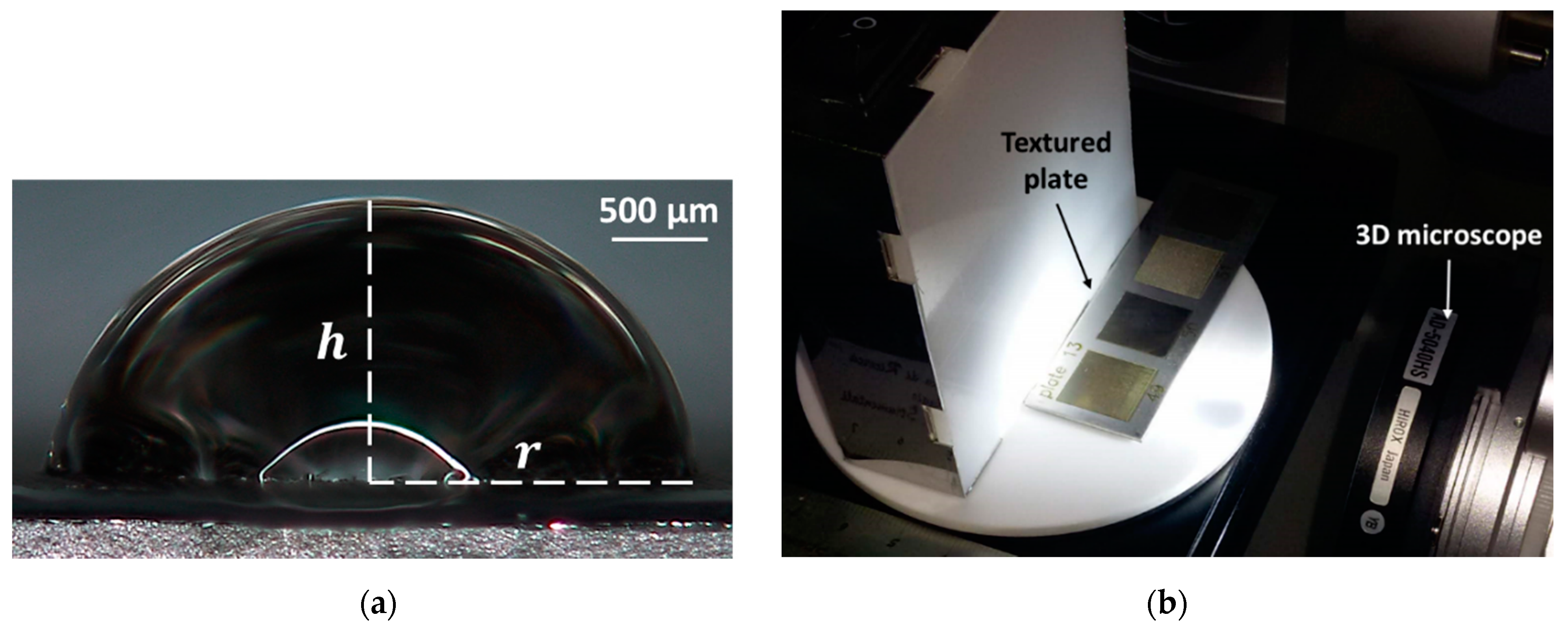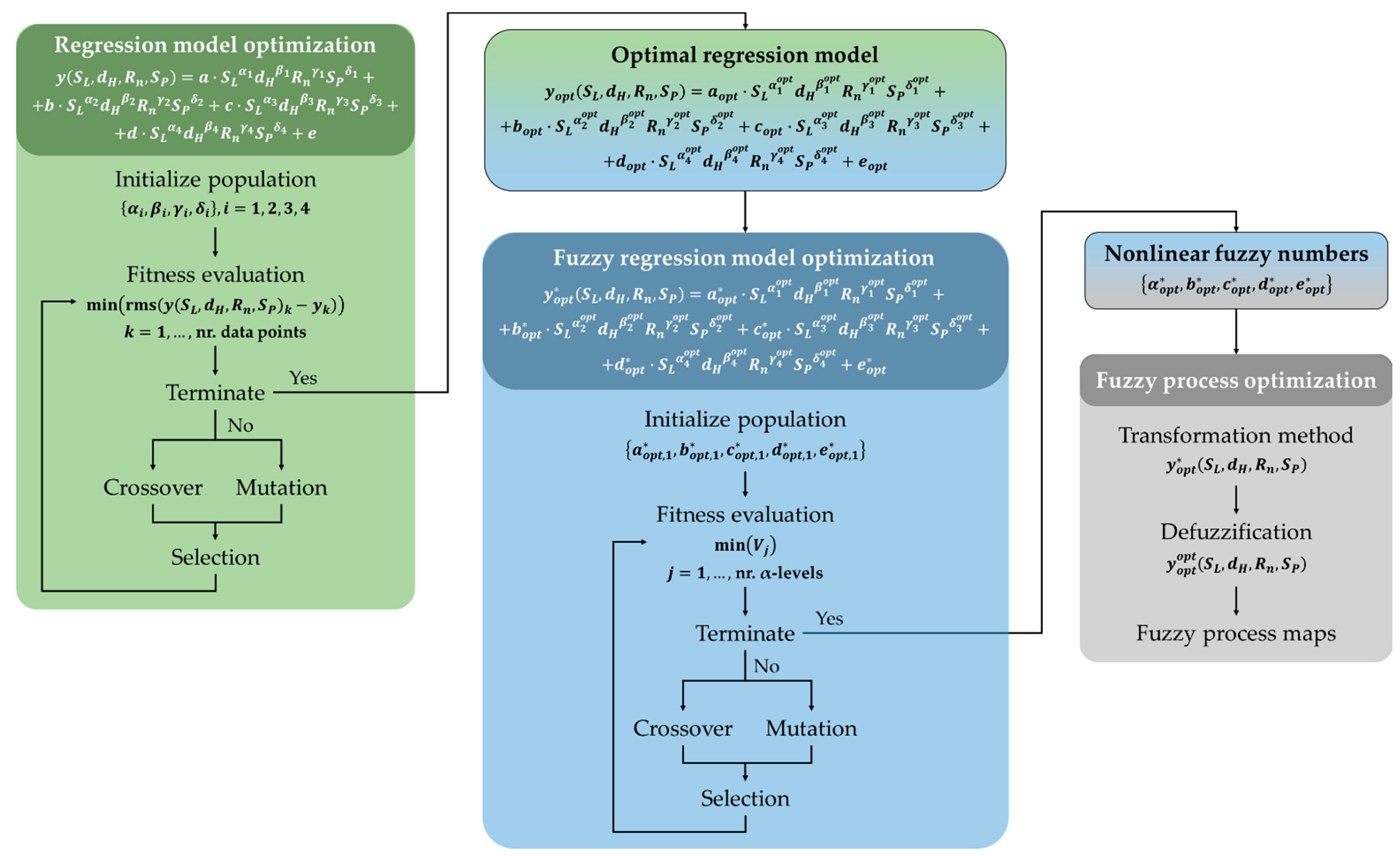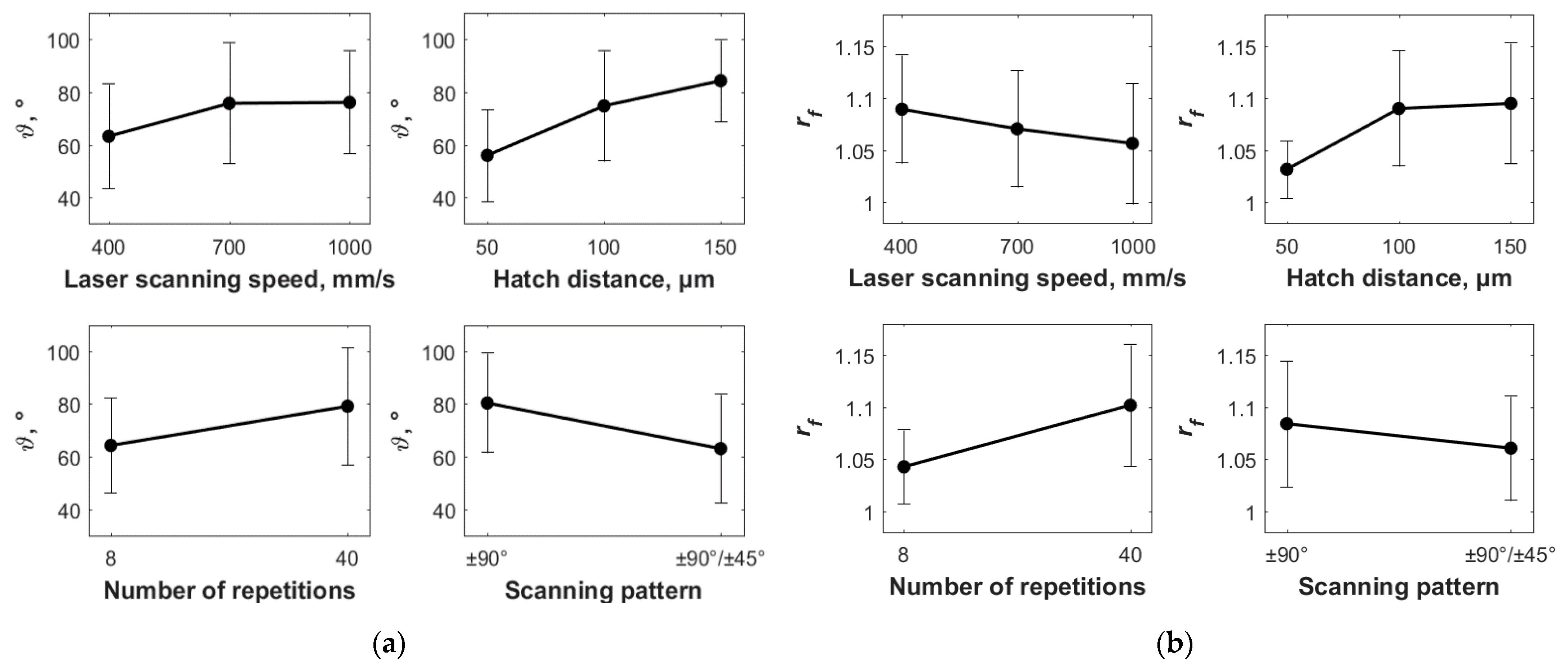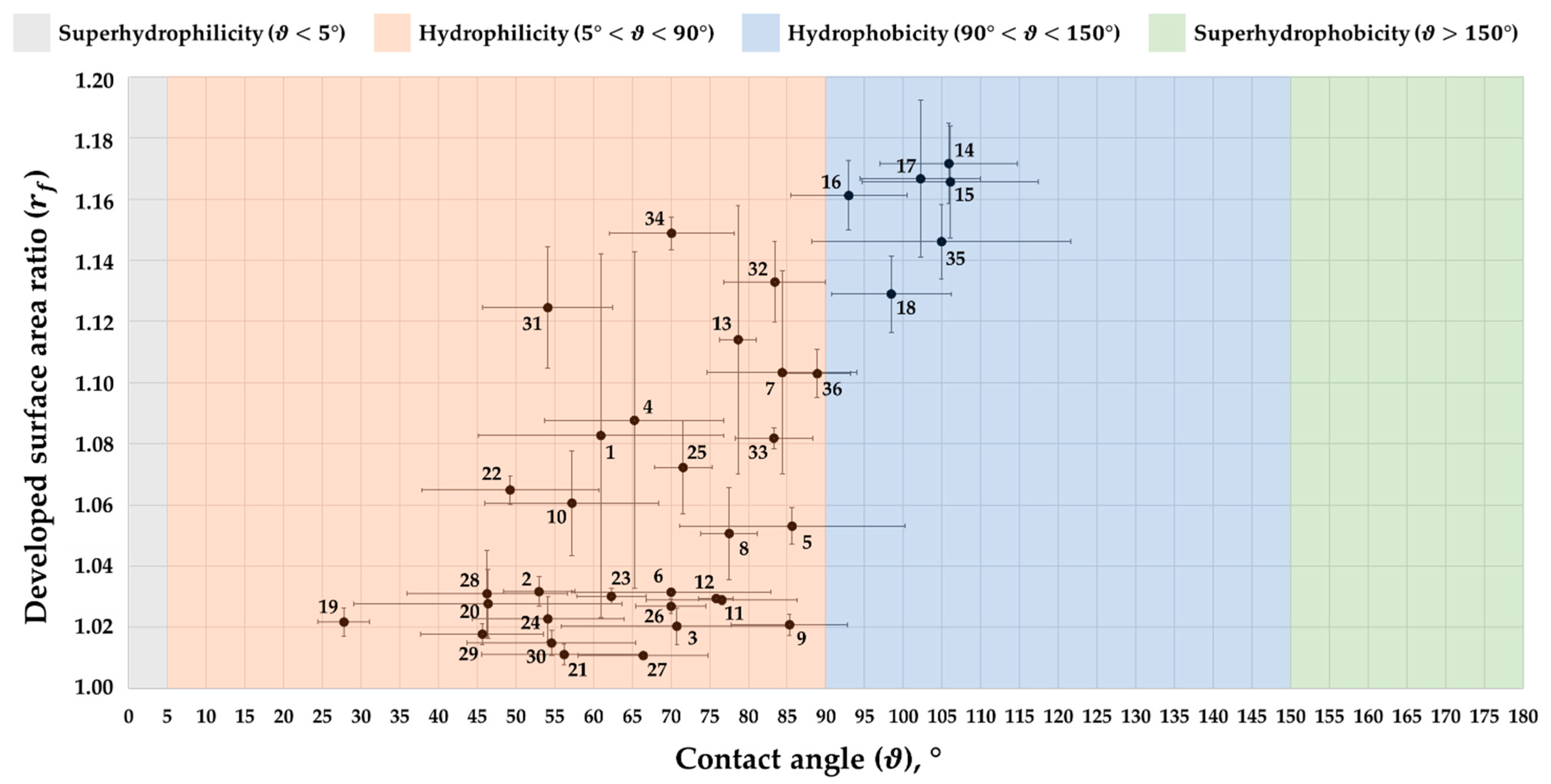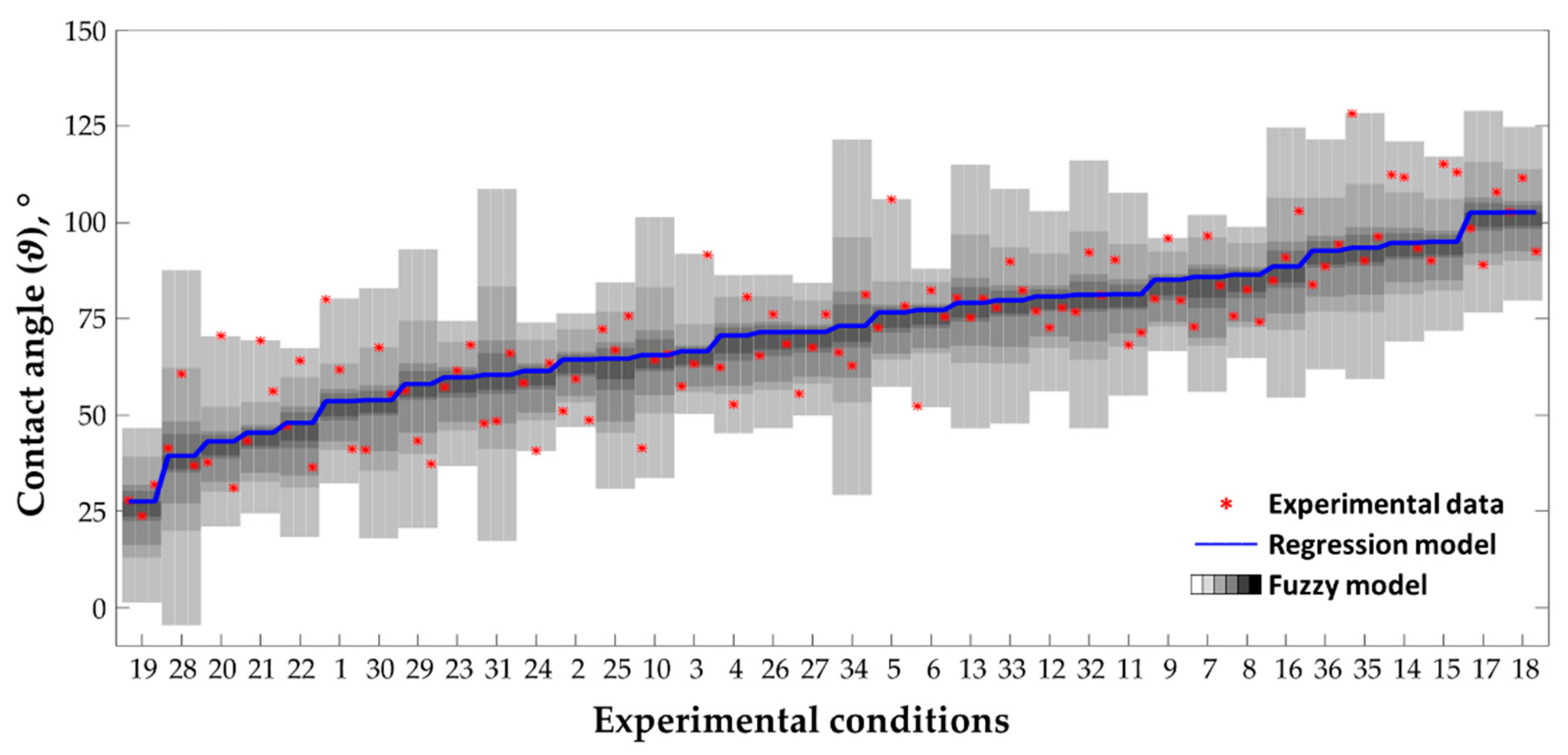3.1. Experimental Findings
In order to consider the wettability states presented in
Section 2.1 valid, the drop size should be at least three orders of magnitude greater than the average roughness [
55]. In this case, in fact, the surface appears uniform to the drop, and the resulting contact angles can be considered as the most stable [
56]. In general, the roughness (
) ranged between 1.032 µm and 10.238 µm, while the diameter of the droplets at the interface with the sample surface,
Figure 2a, between 1.968 mm and 6.514 mm, thus satisfying the mentioned condition.
Figure 5 shows the experimental results in terms of contact angle (
) and developed surface area ratio (
), and how they are affected by the operational process parameters varied in this investigation, i.e., laser scanning speed, hatch distance, number of repetitions, and scanning pattern (see
Table 4 and
Table 5). In particular, in the latter figure, the black dots represent the mean values of the response variables, while the error bars represent the standard deviations. It is worth noting that only the results related to
and
are reported, since the average surface roughness
gives the same kind of information of
in terms of effect on the surface quality.
As shown in
Figure 5, the contact angle (
) and the developed surface area ratio have a similar trend for three of the four control parameters, i.e., hatch distance, number of repetitions, and scanning pattern, while the trend is the opposite for the laser scanning speed. In particular, a higher hatch distance leads to a higher contact angle and developed surface area ratio, therefore promoting the transition from the hydrophilic to the hydrophobic behaviour. In fact, the greater the hatch distance, i.e., the laser scans separation, the bigger the portion of the sample surface which is not ablated by the laser, therefore the more marked the profiles of peaks and valleys, and the higher the roughness and the developed surface area ratio [
49]. Such topography is made of a triple interface between the stainless steel (i.e., solid), of which the sample is made, the air entrapped into the valley (i.e., gaseous), and the distilled water (i.e., liquid) [
57]. As a result, due to the reduced surface tension for the high number of peaks and valleys [
49], the drop assumes a more spherical shape. As a consequence, also the scanning pattern affects the wettability of the surface by promoting the establishment of a hydrophobic behaviour when the laser scans the surface only along with two directions, i.e., ±90°. In fact, the greater the number of laser scans, the smoother the surface, thus the lower the wettability. The same is true for the number of repetitions, for which the higher the number of times the laser scans the same portion of the sample surface, the deeper the groove, the more enhanced the effect peak-valley, therefore the more the hydrophobic behaviour is likely to take place. On the other hand, an increase in the laser scanning speed results in greater contact angles but a lower developed surface area ratio and therefore lower surface roughness. This can be addressed to the fact that by reducing the laser scanning speed, the time duration of the interaction between the laser and the material surface is greater, therefore removing a greater amount of material [
16]. This can lead to the deposition and re-solidification of undesired material from the groove to the surface of the sample, resulting in a reduced average roughness. While, in terms of contact angle, the surface appears to be characterized by a greater number of peaks and valleys and therefore with lower surface tension, thus promoting the hydrophobic behaviour. These findings are supported by the drops’ images recorded for the different process parameters’ combinations, shown in
Figure 6.
It is worth noting here that this discussion is limited to the average trend of the effect of the operational parameters, i.e., laser scanning speed (
), hatch distance (
), number of repetitions (
), scanning pattern (
), on the response variables, i.e., contact angle (
) and developed surface area ratio (
). In order to verify the statistical significance of these results an ANOVA test has been carried out by using the software Minitab. For sake of briefness, the interactions between the parameters were limited to two.
Table 6 reports the results obtained for the contact angle, while
Table 7 for the developed surface area ratio. As can be seen in the latter, the effect of each process parameter can be considered statistically significant:
p-value < 0.0.5, and F-value > 3.97 for DoF = 1, F-value > 3.12 for DoF = 2, or F-value > 2.50 for DoF = 4, where DoF is the degrees of freedom. Therefore, the average trends can be considered representative of the variation of both output variables for varying values of the process parameters.
Finally,
Figure 7 shows the results of the experimental campaign in terms of wettability states obtained for the different combinations of the control parameters here investigated, i.e., laser scanning speed, hatch distance, number of repetitions, and scanning pattern (see
Table 4). As can be seen, only six scenarios are characterized by the hydrophobic behaviour (90° <
< 150°), i.e., 14 to 18 and 35 (
Table 5). All of them are obtained by applying the same number of repetitions, i.e., 40, which is the highest adopted (the other is 8), suggesting them to be the factor that affects the most the wettability of the surface. In fact, as previously highlighted, a greater number of repetitions lead to deeper grooves and therefore to a sharper difference between peaks and valleys, as demonstrated by the higher values of the developed surface area ratio. This result is further supported by the values of the hatch distance, i.e., 100 µm and 150 µm, and the ±90° scanning pattern, which, together with the highest values of the scanning speed, leads to the formation of bigger and sharper asperities that allow the drop to partially sitting on the air trapped between the drop itself and the pockets so formed. In particular,
Figure 8 shows the surface topography of a sample textured by adopting the parameters of the condition 18, i.e.,
= 1000 mm/s,
= 150 µm,
= 40,
= ±90°, compared to the typical surface topography that leads to the hydrophilic state (5° <
< 90°), for example the condition 19, i.e.,
= 400 mm/s,
= 50 µm,
= 8,
= ±90°/±45°. Neither the superhydrophilic state (
< 5°) nor the superhydrophobic one (
> 150°) were observed.
3.2. Fuzzy Optimization
Figure 5 clearly shows that the discussion made in
Section 3.1 about the effect of the process parameters, i.e.,
,
,
,
, on the response variables, i.e.,
and
, can be considered true for the average trend, highlighted by the black dots. While, if the standard deviation is taken into account, highlighted by the error bars, for many of the experimental conditions, the same conclusions cannot be drawn. This discrepancy is typically attributed to the process variability, thus introducing the first source of uncertainty which is of aleatoric type, so when developing empirical models in order to relate input(s) and output(s), this random error can be modelled with stochastic methods by adding an opportune contribution term within the model. However, the model itself introduces a new source of uncertainty due to the simplification assumptions, which are epistemic and therefore not efficiently describable by statistics [
42]. The use of soft computing techniques, fuzzy logic and genetic algorithms, in this case, represents therefore a practical way for developing control systems able to consider both sources of uncertainty at the input level and propagate them at the output level [
36].
The first step, before the application of the proposed fuzzy approach, has been the optimization of the regression models for each output variable (i.e.,
,
,
) through the genetic algorithm developed on the basis of the previous works [
35,
40]. So, starting from the empirical model described by Equation (2), the optimal values of the powers of the model terms, i.e.,
,
,
,
, have been found and applied to evaluate the empirical coefficients (
,
,
,
,
) through standard linear regression. The space of the possible powers is [−1, −0.5, 0, 0.5, 1], therefore discrete and constituted by five terms. Consequently, it contains 5
16 models, where 16 is given by multiplying the number of variables constituting each term with the number of terms, i.e., four in both cases. The constant term is not considered since the powers are fixed to zero. The set of individuals was set at 5000. In general, within these conditions, less than 45 generations were needed to reach the convergence. Therefore, the algorithm solves only 2.25·10
5 models out of 5
16 possible.
Table 8 reports the obtained values of the powers and the resulting coefficients.
The second step concerned the application of the proposed fuzzy approach starting from the optimal regression models found so far, with the aim to optimize supports of the fuzzy numbers, and therefore their shapes, by using another genetic algorithm-based method able to accommodate a varying number of experimental data points according to the membership level, as described in
Section 2.2.
For sake of briefness, in the following, it is reported only the results obtained for the contact angle as a representative case, described by Equation (5), and able to reproduce the measured data with a root mean square error of 8.44% (the mean standard deviation is 8.37%). Starting from the latter equation, the fuzzy numbers
,
,
,
,
, and the fuzzy function
are described by 6 α-cuts. At each of them, the genetic algorithm evaluates the optimal fuzzy support, while the fuzzy function is computed through the transformation method. For each α-cut, it requires, in a combinatorial scheme, the evaluation of the number of points within the α-cut, i.e., 4, to the power of the number of fuzzy parameters, i.e., 5, leading to a total of 6·4
5 = 6144 evaluations for each output variable.
Figure 9 shows the nonlinear fuzzy numbers identified by applying the developed genetic algorithm. In this figure, the x-axis represents the support of the fuzzy numbers, which are optimized at each α-level, thus obtaining a peculiar shape for each of them, while
Figure 10 reports the results of the fuzzy model implementation order for increasing values of the contact angle:
From
Figure 9 it is evident that the most influencing factors are those associated with the first and the last coefficients, i.e.,
and
. The first is associated with the combination of laser scanning speed, hatch distance, and the number of repetitions, while the last is the constant term. The other three terms, i.e.,
,
,
, are characterized by very small support almost coincident to the corresponding modal value, which is already reached at the fourth α-level. This suggests that the regression model optimized through the genetic algorithm is still lacking some information about the relation between the input process parameters and the output, i.e., the contact angle in this example. This is due to the simplification introduced by the model itself. However, such uncertainty can be taken into account, with the proposed fuzzy approach, together with the uncertainty associated with the process variability, and propagated to the output qualities through the transformation method. The result is a fuzzy process map in which the extent of the fuzzy bands varies depending on the operational parameters’ combinations used during the experimental tests (see
Figure 10). It is worth highlighting that the extent of the uncertainty bands is related to both the accuracy of the regression model and the variability of the process. In particular, the operator is warned of the degree of uncertainty, which is particularly high for the combinations 10, 13, 16, 28, 29, 30, 31, 33, 32, 34, and 35 (see
Table 5 for the details). As a result of the genetic algorithm optimization, the fuzzy model represents the optimal “uncertain” description of the relation between the process parameters and the process outcomes, which accounts for all the sources of uncertainty, i.e., process variability, approximation due to the linear regression, and for any measurement error during the characterization of roughness and contact angles. The membership function μ, represented as greyscale, ranges from 0 (i.e., white) to 1 (i.e., black) and describes the degree of belonging of a given sample to the model, i.e., from 100% (at μ = 0), which represents a non-precise model that take into account all the experimental data, to 0% (at μ = 1), that is the crisp regression model and upon which no measured data point falls on.
Moreover, the fuzzy model can be used to identify the most suitable combination of the process parameters in order to satisfy a desired requirement. In this case it has been implemented for the obtainment of a specific wettability state, i.e., hydrophilic (5° < ϑ < 90°) or hydrophobic (90° < ϑ < 150°), which are the only two wettability states observed during the experimental campaign. For sake of briefness,
Figure 11 shows the fuzzy inverse maps obtained for the contact angle belonging to the hydrophobic state drawn by considering the combination of two parameters at a time while keeping the others constant, in this case at their maximum levels except for the scanning pattern, i.e.,
= 1000 mm/s,
= 150 µm,
= 40,
= ±90°. Moreover, in the latter, the experimental results are highlighted by red dots and the relative occurrences by green numbers.
From the inspection of
Figure 11, if adopted for the control of the surface wettability, the operator is warned of the variability of the process due to the width of the fuzzy bands that suggest the level of uncertainty related to the specific parameters’ combination. For example,
Figure 11 suggests that the hydrophobic state can be promoted by adopting a high number of repetitions, greater than 24, while keeping the hatch distance over 75 µm, the laser scanning speed over 600 mm/s, and limiting the scanning pattern to ±90°. In these scenarios, in fact, the fuzzy areas are darker and narrower, thus representing the parameters’ combination characterized by the lowest level of uncertainty. In other words, within these operational conditions, the possibility to obtain the desired quality is the highest. These findings are also supported by the experimental data. In fact, the highest number of occurrences (i.e., 3) falls on the darkest areas of the fuzzy inverse maps. In fact, as reported in
Section 3.1, an increasing value of the hatch distance, number of repetitions, and scanning speed, together with limiting the laser scanning to only two directions (i.e., ±90°), results in a higher contact angle. This happens because in such conditions the profiles of peaks and valleys are more marked and therefore characterized by a reduced surface tension that let the drop to assume a more spherical shape [
49], which is characteristic of the hydrophobic state.
These results reveal that the proposed approach based on a combination of soft computing techniques, i.e., genetic algorithms and fuzzy logic, in this case, can be considered a useful tool in estimating regression parameters when the experimental data set is characterized by a non-negligible dispersion between the data points, thus making the statistical regression analysis not suitable to suggest a regression model due to the vague relationships among variables and poor model specification.

